Contents:
Common Names | Parts Usually Used | Plant(s) & Culture | Where Found | Medicinal Properties
Uses | Warning | Bibliography
Scientific Names
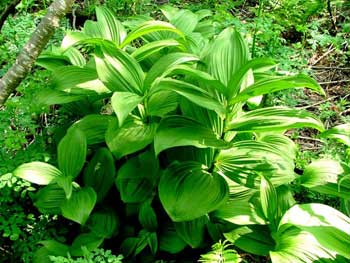
Veratrum viride Ait |
- American White or False
- Veratrum viride Ait.
- Liliaceae
- Lily family
- Helleborus niger
- Hellebore foetidus
- Hellebore viridis
- Buttercup family
- False Hellebore
- Adonis vernalis L.
- Ranunculaceae
Common Names
Veratrum viride, Ait. common names:
- American Hellebore
- American White Hellebore
- Bugbane
- Earth gall
- Green hellebore
- Hellebore
- Indian poke
- Itchweed
- Swamp hellebore
- Tickleweed
- White hellebore
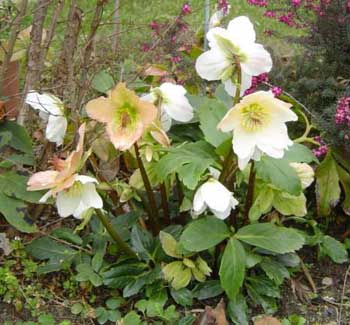
Helleborus niger |
Helleborus niger common names:
- Black hellebore
- Christmas rose
Helleborus foetidus common names:
- Bearsfoot
- Christmas flower
- Christmas herb
- Fetid hellebore
- Oxheal
- Setter-grass
- Setter-wort
- Stinking hellebore
Helleborus viridis common names:
- Green hellebore
- Winter hellebore
False hellebore common names:
- Adonis
Parts Usually Used
American hellebore; rootstock
Helleborus niger: rootstock
Helleborus foetidus: rootstock, herb
Helleborus viridis: rootstock
Back to Top
Description of Plant(s) and Culture
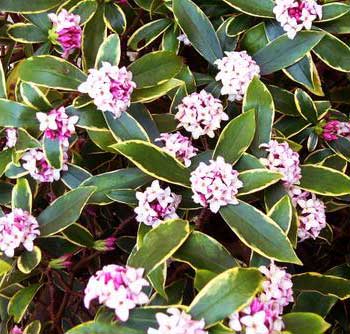
Hellebore viridis |
Any of a genus (Veratrum) of poisonous plants of the lily family.
American hellebore (V. viride) is a perennial plant whose branched stem may grow from 2-8 feet tall. The root stock is thick and fleshy and has many large whitish roots. It has a strong, unpleasant smell when fresh and a sweetish-bitter, somewhat acrid taste. The leaves are alternate, changing from oval near the bottom to lanceolate or linear at the top. A more or less drooping panicle of star-shaped, green flowers appears from June to August.
Any of a genus (Helleborus) of poisonous, winter-blooming plants of the buttercup family, with buttercuplike flowers of various colors: the rhizomes of a black European species (H. niger) were formerly used as a heart stimulant and cathartic.
Helleborus niger: The simple stem grows as high as 1 foot and bears a few small leaflets. The basal leaves growing from the rootstock are dark green, leathery, petioled, palmately 7-9 parted. The large, white showy flowers appear from December to March.
Helleborus foetidus: stem is branched and bears leaves that grow from pale green sheaths. The greenish and bell-shaped flowers appear from March to May.
Helleborus viridis: similar to black hellebore, but its stem is branched, each branch bearing one flower in conjunction with a palmately compound leaf. The flowers appear in March and April.
False hellebore (Adonis vernalis): grows 6-12 inches high, with delicate, finely cut leaves, false hellebore produces large yellow flowers of about 10-20 petals in May or June. Adonis may be grown from seed sown in spring or early fall, or root divisions in spring. It prefers light, sandy soil.
Another plant: known also as white hellebore (Veratrum speciosum) was used by the Native Americans. The Blackfeet called it “Etawa-asi.” The dried root was pounded and snuffed.
Back to Top
Where Found
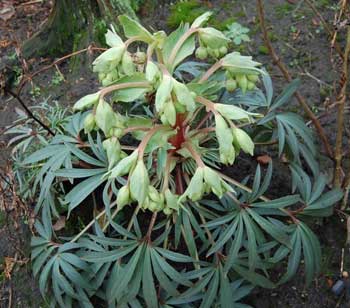
Hellebore foetidus |
American hellebore: found in swamps, moist meadows, wet wood edges, and low grounds from Canada to Georgia, as far west as Minnesota, and in the mountains of the Pacific Coast states.
Helleborus niger: black hellebore is a perennial plant cultivated and found wild around the edges of forests in the subalphine and southern parts of Europe. It has also been introduced into the United States as a garden plant.
Helleborus foetidus: bearsfoot is a European perennial that grows on the dry, rocky slopes of the Alps.
Helleborus viridis: a European perennial found mostly in alpine forests.
Adonis (False hellebore): sandy soil areas in United States. Cultivated.
Back to Top
Medicinal Properties
Helleborus niger: diaphoretic, emetic, expectorant, febrifuge, narcotic.
Helleborus foetidus: diaphoretic, emetic, expectorant, febrifuge, narcotic.
Helleborus viridis: diaphoretic, emetic, expectorant, febrifuge, narcotic, sedative
Back to Top
Uses
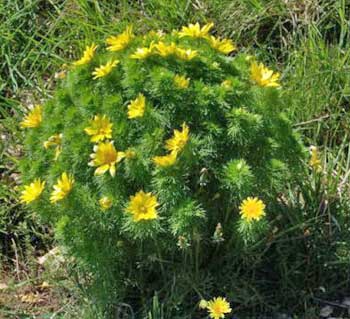
Adonis vernalis L |
American hellebore: acts as a cardiac depressant. Deaths are recorded from overdoses of the drug. Sometimes the leaves are gathered and cooked as a vegetable by mistake, with severe skin reactions and poisoning as a result. Used as pharmaceutical drugs to slow the heart rate, lower blood pressure; also for arteriosclerosis, and forms of nephritis. The root is used in insecticides. All parts, especially the root, are highly or fatally toxic.
Helleborus niger: The leaves and rootstock contain a variety of glycosides similar in activity to digitalis. Contact with the bruised herb may also cause dermatitis.
Helleborus foetidus: Bearsfoot is said to be the most active of the hellebores, having basically the same properties as black hellebore. It is rarely used. If side effects happen after taking this herb, goat’s milk is the cure.
Helleborus viridis: Green hellebore is like black hellebore, but it is more potent. It is rarely used.
A near relative, (Adonis autumnalis), is also sometimes called false hellebore, as well as pheasant’s eye and red chamomile. It is a European native, growing about a foot-high and having finely cut leaves and small scarlet flowers. Considered poison. Has much the same actions as H. niger, etc. An insecticide from the roots and sold in the form of a dry powder. It is potent only when fresh, and although rather expensive, is used on ripening fruit and vegetables. It is a slow stomach poison for insects and especially useful against currant worm and all chewing insects such as beetles, caterpillars, grubs, cutworm, and grasshoppers. Usually mixed with flour or dehydrated lime and used as a dust, it can also be mixed with water for a spray, about 1 oz. to 2 gal. of water.
Back to Top
Warning
American hellebore (leaves have been mistaken for Pokeweed, or Marsh-marigold, then eaten with fatal results), H. niger, H. foetidus, H. viridis and false hellebore (Adonis vernalis): All four are considered too dangerous for anyone who is not an experienced herbalist or botanist. These herbs are not for use without medical direction under any circumstances.
Back to Top
Bibliography
![]() The Herb Book
The Herb Book, by John Lust, Bantam Books, 666 Fifth Avenue, New York, NY. copyright 1974.
![]() Culpeper’s Complete Herbal & English Physician: Updated With 117 Modern Herbs
Culpeper’s Complete Herbal & English Physician: Updated With 117 Modern Herbs, by Nicholas Culpeper, Meyerbooks, publisher, PO Box 427, Glenwood, Illinois 60425, 1990, (reprint of 1814)
![]() Eastern/Central Medicinal Plants
Eastern/Central Medicinal Plants, by Steven Foster and James A. Duke., Houghton Mifflin Company, 215 Park Avenue South, New York, NY 10000
![]() The Nature Doctor: A Manual of Traditional and Complementary Medicine
The Nature Doctor: A Manual of Traditional and Complementary Medicine, by Dr. H.C.A. Vogel; Keats Publishing, Inc., 27 Pine Street (Box 876) New Canaan, CT. 06840-0876. Copyright Verlag A. Vogel, Teufen (AR) Switzerland 1952, 1991
![]() Indian Herbalogy of North America
Indian Herbalogy of North America, by Alma R. Hutchens, Shambala Publications, Inc., Horticultural Hall, 300 Massachusetts Avenue, Boston, Massachusetts 02115, 1973
![]() Indian Uses of Native Plants
Indian Uses of Native Plants, by Edith Van Allen Murphey, Meyerbooks, publisher, PO Box 427, Glenwood, Illinois 60425, copyright 1958, print 1990
![]() American Folk Medicine
American Folk Medicine, by Clarence Meyer, Meyerbooks, publisher, PO Box 427, Glenwood, Illinois 60425, 1973
![]() Webster’s New World Dictionary
Webster’s New World Dictionary, Third College Edition, Victoria Neufeldt, Editor in Chief, New World Dictionaries: A Division of Simon & Schuster, Inc., 15 Columbus Circle, New York, NY 10023
 The Rodale Herb Book: How to Use, Grow, and Buy Nature’s Miracle Plants (An Organic gardening and farming book)
The Rodale Herb Book: How to Use, Grow, and Buy Nature’s Miracle Plants (An Organic gardening and farming book), edited by William H. Hylton, Rodale Press, Inc. Emmaus, PA, 18049., 1974
